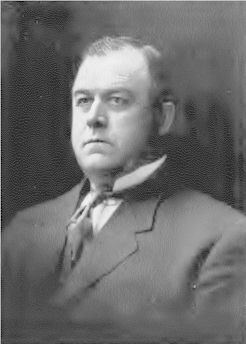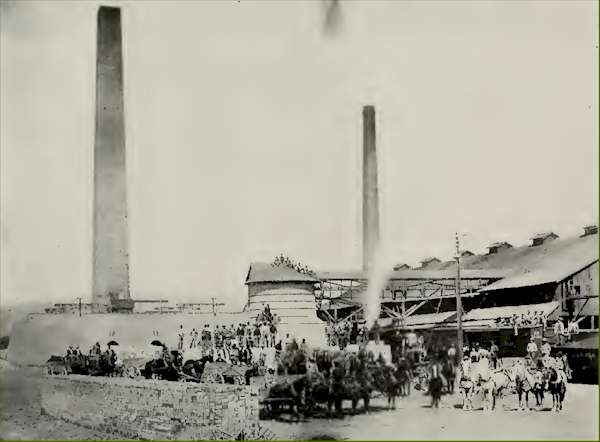The Brick and Brick-Making
A brick is
such a common, such a plebeian thing that the average person has
perhaps never given it a second thought. Inquiry would probably
develop the fact that he had a somewhat hazy idea that it was
made of earth and baked in some way perhaps like a baked potato
or a pan of biscuits and that was about all he knew about it. If
this average man were told that there is a concern in Salt Lake
making 200,000 brick per day enough to build ten modern
five-room houses he would probably be incredulous and want to be
"shown," and yet it is true.
The Salt Lake
Pressed Brick Company is that concern, and in the number of
employees and value of product it stands well up in the list of
large manufacturers in Utah. Its extensive plant is located at
Fourteenth South and Eleventh East Streets, Salt Lake City. When
the original plant was built, in 1891, it was only after
exhaustive explorations for and tests of clay beds containing
suitable brick material throughout the valley generally, from
points in Davis County on the north to the vicinity of Sandy on
the south. Time and experience have justified the wisdom of the
selection then made. Not only has the clay proved admirably
adapted to the manufacture of the finest brick, but it has been
found to exist in unexpected quantities. The beds are in some
places fourteen feet thick and are known to extend east from the
factory for a mile and a half and to considerable distances in
other directions. The company now owns 150 acres of these clay
lands, and has the material to make brick for years to come. The
plant itself covers nearly ten acres of ground. In its
construction 10,000,000 brick were used, more than were required
in building any ether structure or plant in Utah, the great
Garfield Smelter alone accepted. The whole plant is lighted and
operated, so far as power can be applied, by electricity
generated by two water-propelled power plants, one located in
Big Cottonwood Canyon and one in Mill Creek Canyon.

John P. Cahoon, General Manager
The first
brick plant built by the company had a capacity of 20,000 brick
per day which has now grown to 200,000 per day, and it is harder
to keep up with the demand now than it was then. Such success is
not usually achieved without merit, the product of the company
being a superior article, whether the high-grade white or red
pressed brick of which so many handsome buildings in Salt Lake
are constructed; or the common brick used in inside and back
walls. This superiority is due to perfect material, adequate
equipment and efficient management combined with "knowing how."
These things have given the brick produced by this company a
wide fame throughout the inter-mountain country and they are
extensively used all over Utah, Nevada, southern Idaho and
western Wyoming, going as far west as Goldfield, Nevada, and
Boise, Idaho, and north to Butte, Montana. Twenty-five of the
largest school buildings in Salt Lake City, besides scores of
other large buildings and many hundreds of residences, have been
built from the product of this factory. There is a rail-road
switch to the factory from the Park City line, affording good
shipping facilities.
The clay is
plowed from the beds where nature placed it and scraped to the
loading chutes where it falls into cars each holding enough to
make 2,000 brick, and is run by mule power on an easy down grade
to the clay sheds which have a storage capacity sufficient to
run the factory through any period of rainy weather that may
occur. From here the clay is carried by a system of endless belt
conveyors and elevators through automatic machinery which
grinds, screens and tempers it, finally depositing it in bins
above the presses, which are to form it into brick. From these
bins it drops by gravity down a chute into the presses. These
are of two types, the mold presses which shape each individual
brick separately under enormous pressure, and the wire cut press
in which the continuous column of compressed clay forced from
the orifice of the machine is automatically sliced into brick,
twenty at a clip. Of the first type of machine there are four in
use, two of six molds each and two of four. These are used for
making the better grades of pressed brick and their combined
capacity is 110,000 brick per day. Of the wire cut type there is
but one machine in use, but it is a hustler, turning out
approximately 100,000 common brick per day. In the new kiln,
where the common brick are made, the handling of the brick by
hand is all but eliminated. This new kiln was built late in
1907, but was not put into service until the summer of 1908. It
is an immense affair, 1160 feet in length, including the storage
space, and 110 feet wide. It is what is called an open-top,
continuous kiln, and was built from designs original with Mr. J.
P. Cahoon, manager of the company. Its capacity is 4,000,000
brick. It consists of a double row of kiln chambers and over
each row travels a huge electric crane which picks up 2000 brick
at a time and gently deposits them either in the drying
department, in a kiln chamber for firing, in the storage space,
or in the railroad car for shipping, as may be desired. The
brick are handled in crates and the breakage is less than it
would be by hand, while the saving in labor can hardly be
estimated. Another feature of the new kiln is that it has no
stack, there being substituted for it to create the necessary
draft, an enormous fan, driven by a fifty-five horse-power
electric motor.

One of the Plants, Salt Lake
Pressed Brick Company
The finest
pressed brick are burned in the Kessler kilns, six in number and
holding about half a million brick. These brick are burned from
twenty-two to thirty days and are heated to a white heat. There
is one Hoffman continuous kiln having twenty-two chambers and a
capacity of 700,000 brick, and one tunnel continuous kiln with
eighteen chambers and a capacity of 550,000. The aggregate
capacity of all the kilns is 5,750,000 brick, or 220,000 for
every working day, the time required in drying, burning and
cooling the brick being about thirty days. In other words, in
thirty days from the time a brick is molded it is ready for the
market.
A continuous
kiln is one in which the fire is burning all the time. It
consists of a series of connected chambers arranged either in
the form of an oval or in two parallel rows, and the fire passes
slowly from chamber to chamber, so that some chambers are being
filled, others are burning and others are being emptied, all at
the same time. This system economizes fuel, and this economy is
carried further by utilizing the waste heat from the burning
chambers in drying the freshly molded brick. Crushed coal, or
slack, is used for fuel and is fed into the kilns through small
holes in the top, about a teacupful being put into each hole
every half hour. An intense, even heat, that can be regulated
perfectly is thus secured and maintained as long as desired. As
they come from the kiln all brick except the common are sorted,
or shaded as it is called, to secure absolute uniformity of
color and quality. Certain red clay produces the red brick,
other clay produces the white brick, and the color is also
somewhat affected by differences in burning.
The company employs about 200 men and
has $30,000 invested in teams engaged mainly in delivering brick
throughout Salt Lake City. A roomy, convenient and up-to-date
brick office building is now under construction and will be
ready for occupancy in a few weeks. A down-town office is
maintained at 126 Main Street, where an interesting display of
the products of the factory may be seen. John P. Cahoon is
president and manager of the company; George Curley,
vice-president; Wm. S. Simkins, treasurer.

Index

Source: Sketches of the Inter-Mountain
States, Utah, Idaho and Nevada, Published by The Salt Lake
Tribune, Salt Lake City, Utah, 1909
|


